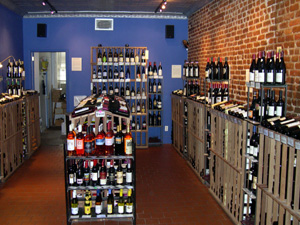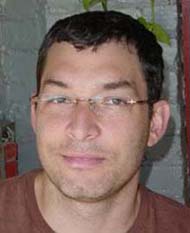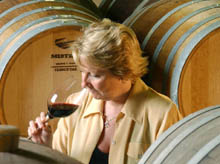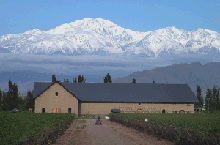Dr Vino's wine blog
wine talk that goes down easy
Summer wines at BNFB

When I walked into Big Nose Fully Body on a warm summer day last week there were three new wines on the counter: a Greek white, a French rosé, and a Lebanese red. That about sums up the diversity at this charming neighborhood shop.
If I were a movie reviewer, I’d give the shop two thumbs up, way up. Or if I were Robert Parker, I’d give it a 95. By any rating system this shop scores high. I would love to have this shop right around the corner from my house.
The shop doesn’t have an enormous selection but it does have a great selection. And with almost as many different wines as there are days in the year, and conveniently located near the F line subway station, locals should consider this their own cave. Moreover, the wines are not only ready to drink but they are priced to drink. Only a few champagnes seemed to crack the $25 mark (but there were even some sparklers for under $10).
Pat does not buy her wines from an importer such as Greg nor does she buy them directly from a producer such as Susana. Instead, she buys them from about 25 distributors who act as intermediaries between the producers and the retailers. Although she works with a couple of big distributors such as Lauber, she works mostly with smaller distributors who have niche specializations or smaller, more focused “books” as their portfolios are known in the trade.
For example, she recently had a wine from California at a restaurant and inquired about who was the distributor, hoping to get it for her shop. She learned that it was distributed by Angels Share in Brooklyn and since that’s the location of her shop, she thought it would be a snap. But in the end the distributor didn’t have a listed phone number so she put it on the back burner. A few days later, she got a call from one of the two principals at Angels Share asking if he could be of assistance.
In the end, the California wine was too expensive for her shop, but Angels Share also had some Spanish wines that she liked (including the Castillo de Fuendalejon, the bottle in the bag, which I purchased at the shop and review as my wine of the week this week).
Wine distributors in New York state offer discounts for larger orders, Pat explained to me. They quite often offer a price for one case, but then discount that by about five percent if she takes three cases. Five, ten and 25 case orders all get steeper discounts but those are rare for Pat’s small shop. The shop’s temperature controlled basement stores some wine inventory that Larry, the assistant manager, keeps assiduously arranged.
But even though it is a small shop trading on a convenient location and knowledgeable staff, the prices are still good. Pat says that sometimes she wants to stock a wine that is too expensive, she will offer at a lower price than the normal markup. And she sometimes scrounges the distributors’ lists to find any interesting wines they may be trying to move and offers those at reduced prices as well.
The distributors come and pour their wines for her to sample at the shop. If she wanted, she says that she could have as many as three a day visiting her, each pouring five or six wines. While this might be reason enough alone for some entrepreneurs to purchase a wine shop, Pat says she tries to keep them at bay until she has a gap to fill. “I taste every wine that is in the shop,” Pat said.
Since she is also a wine writer, she writes up her impressions of a wine and hangs a tag in front of each bottle. Parker scores? Not in this shop. “Scores won’t tell the customer whether the wine will go with chicken salad for lunch,” she said.
The shop’s window display (and street scene in reflection!)
Oddly enough, given her background at IBM in e-commerce, Pat never really thought about selling wine through the web. “There’s just not enough space for shipping boxes,” she explained. “Occasionally our email newsletters get forwarded and we get requests, which we try to honor, but it is logistically difficult.”
About five percent of sales are rosé wines in the summer and white wines climb to parity with reds. Before I trundled off to the coffee shop next door, Pat suggested a few summer picks:
* Routas, rosé, 2004, province, $9.
* Castello de Bossi, 2001, $16 (closeout)
* Pierre Boniface, white, vin de Savoie (of course!), $12
* Notios, Pelopennisis, 2004 (white) – just in, as yet unpriced.
Patricia Savoie, selling the wines of the world
 Big Nose, Full Body is celebrating its fifth year serving the Park Slope area of Brooklyn. Patricia Savoie started a new chapter in her life by purchasing the shop two years ago after a life-changing event: she lost her job.
Big Nose, Full Body is celebrating its fifth year serving the Park Slope area of Brooklyn. Patricia Savoie started a new chapter in her life by purchasing the shop two years ago after a life-changing event: she lost her job.
Pat, a veteran of several large corporations including McKinsey, Nabisco, Cablevision and most recently IBM, specialized in strategy and marketing in her corporate life and contributed to IBM’s shift toward consulting and away from hardware. Ultimately, after several restructurings of the e-commerce consulting group, Pat was let go on September 10, 2001. She didn’t think her life could get any worse.
The trauma that New York and America felt that September left Pat doing some soul searching. She decided, as many Americans did after that fall, to pursue her passion. In this case wine had brought her much joy throughout her life. She and her former husband had joined several wine tasting groups in the 1970s and had even co-authored a book together, The Wine Tasting Course (1978).
A friend asked her to collaborate on an article for Wine Enthusiast and Pat started to think more about wine and writing. She then wrote two stories for Wine Business Monthly. But as her severance started to reach its end, she started to think more about cash flow as well as wine. Glancing through the New York Times business opportunities listings, she saw a wine shop for sale in Brooklyn. She thought, why not?
Two months later the shop was hers. The witty name and the décor of vivid blue walls and pressed tin ceiling are thanks to the original owners, a thirty-something Canadian couple who returned to Canada when they sold the shop.
But Pat has changed almost all the wines stocked in the shop, filling the store with the wines she likes, mostly from off the beaten path. The store will not have every wine from a given region, but it will have a few wines from almost any region, including Pinotage from South Africa, wines from Turkey and Slovenia, and a 100% Xarelo white from Spain.
“We have breadth not depth,” Pat told me on the phone recently. She currently has between 300-350 different wines, which makes for a lot of wine per square inch given that the shop is a mere 400 square feet (37 square meters). And with 80 wines under $10, free tastings on Saturdays, and occasional $5 bottles, it is a good place for readers of DrVino.com.
This selection and the service that Pat and her knowledgeable staff provide have led to a glowing write-up in the New York Sun, the Village Voice called the shop “the best neighborhood wine shop” in November 2004, and Saveur declared it their “favorite wine shop name bar none” in January 2005. “Now people in Manhattan may say ‘oh I’ve heard of that shop,'” Pat proudly proclaims.
Pat particularly likes two aspects of owning the shop: the customers and the opportunity to taste. The neighborhood feel means “we almost always have a baby stroller in the shop.” When a customer comes back to the shop and says “the wine was perfect,” she could not be more pleased. And being a good New York shop, they also deliver—free in the immediate neighborhood and for a fee elsewhere.
Being a shop owner means that wine distributors come and parade their wines in front of her on a regular basis. As a member of the trade, she also attends the numerous trade tastings in New York, always trying new wines. “My wine knowledge has increased a lot in the past two years,” she says.
But with the shop open until 9PM on weeknights and during the day on Saturday, Pat finds it difficult to keep up her wine writing—not to mention her social life.
I look forward to talking with Pat in the coming year about consumer preferences, labels, the role of critics and shelf-talkers, and wines off the beaten path among other subjects. I also look forward to watching her in action at a trade tasting. Should be fun stuff. Check back regularly.
Gregory Smolik, importing artisanal wines of Italy
 Gregory Smolik has taken the plunge. In January 2004, at age 36, he left Sam’s Wines and Spirits, the large Chicago wine retailer, and went off on his own to import artisanal wines from Italy. He’s still in the start-up phase of his new life as a wine importer but his chances of success are good given his background, his philosophy, and ultimately, his wines. In the year ahead, Greg aims to add more producers and more US states that carry his wines.
Gregory Smolik has taken the plunge. In January 2004, at age 36, he left Sam’s Wines and Spirits, the large Chicago wine retailer, and went off on his own to import artisanal wines from Italy. He’s still in the start-up phase of his new life as a wine importer but his chances of success are good given his background, his philosophy, and ultimately, his wines. In the year ahead, Greg aims to add more producers and more US states that carry his wines.
During his six years as Italian wine buyer at Sam’s Greg presided over one of the largest selections of Italian wine under one roof. Sam’s had one 25,000 square foot store on the north side of Chicago with about 9,500 different wines in stock when Greg left (they have added a suburban location since then), so this is no corner shop. Greg built the Italian wine portfolio from 350 wines to about 2000 through several buying trips to Italy.
Greg was most excited about introducing new wines to consumers. He found many small scale producers in Italy, arranged to have them imported and sold at Sam’s. Some of these wines are no longer around but others have grown to multi-million dollars in sales.
Having visited numerous wineries, talked with hundreds of producers and sold wine to legions of customers, the transition to importer was an easy one. Greg knew what kind of wines he wanted to have in his portfolio and what kinds of labels would appeal to American consumers. “I didn’t want to have corporate wine that says ‘made in Italy’ but could really have been made anywhere. I care about where wine comes from, not a tank or a barrel. I have a story to tell and there’s a lot of passion behind that story,” Greg told me on the phone last week.
Fans of the big and oaky wines known as “super Tuscans” will be disappointed as rustic authenticity best summarizes what Greg looks for in a wine. He only works with family-run wineries in four regions of Italy: Lombardy, Campania, Basilicata, and Calabria. One of his producers, Cabanon is biodynamic. “I seek wines with the least amount of altering of the grape and the soil.” He describes his wines as “clean but expressive.” The wines in his portfolio retail in the $7 -$25 price range. Amazingly, he imports only about 1,200 cases of wine a year from four producers, but is looking to scale up.
An amateur musician, Greg also says that he is artistic and enjoys designing labels. But the bureaucratic side can be frustrating, as label approvals from the government authorities can take months. “I’m just starting out and can’t afford lawyers to rush them through,” he laments. “Label approval alone gives me gray hair.”
His wines are mainly available in Chicago, but he has recently picked up distribution in Nevada and Wisconsin. (Greg sells his wines to distributors who then sell them to retailers. His Illinois distributor, Maverick, has provided financial backing for him as well as a sales team.) Given his view that Chicago is “the most competitive wine market in the country,” he has cut his teeth on the hardest location and laid a good base for his expansion. He plans to add a dozen states over the next year including New York, Florida and Texas.
He is a passionate cook and the only thing he likes better than finding the right wine is finding the right food. The crisp white Falanghina paired with greens sautéed in garlic and olive oil, the fruity red Aglianico with the salt of veal—these are pairings that elevate the food and the wine, and drive him to keep finding good wines.
His wines have appeared not only in the leading shops in Chicago but also in some leading restaurants. Alinea, a cutting-edge new restaurant from chef Grant Achatz with a 25 course tasting menu, has included Greg’s I Portali wine with the squab. “A perfect match,” Greg declares with satisfaction.
In the next year, I look forward to seeing Greg in action, as he sells his wines, talking with him about logistics and labels, the financial side of the importing, and how he finds new producers for his portfolio. He’s off to Sicily and Campania for a week so we’ll check in with him when he gets back. Stay tuned!
What would you like to know about Greg? Send in your questions.
Greg currently has no website. That’s something on his plate for the near future.
> 6/30: Question from Terry in New York
I am fascinated with Greg Smolik’s venture, as I am now writing for the Italian wine blog Aristide and plan to help the owner of the blog do an English-language version based here in NYC. My main question for Greg (now): where does he think the US market for vitigni autoctoni (indigenous Italian varieties) will be in 5 years?
> 7/1: Greg’s reply
(Great timing for this question) What’s happening is a resurgence and/or a realization that good old fashioned wholesome quality can not only be attainable but that consumers are becoming more educated and particular in food AND wine especially in the U.S. where there is the drive to be authentic. Statistics prove that Americans love to travel especially to Italy and take as much of it in as they can, Appreciation for the culture, the uniqueness of the wines and confidence in themselves as far as pairing food and wine are all ways that can help me describe why I think indigenous wines will prosper in the next five years. I see indigenous or traditional flavors in wines catching up to all the great chefs who have been making food this way for some time, after all its not the presentation its the quality that goes into food and wine that makes someone come back, but I’m being wordy, I don’t think these types of wines will double in the next five years due to the fact that there are just so many Italian wines out there also there are too many financially powerful, over-marketed wines that leave the market bloated but I do believe that they have certainly taken root and will prove themselves as people are understanding more and more about the nuances and the essence of tradition, culture and genuinity.
Susana Balbo, making wine in Mendoza
It was 25 degrees (-6C) in Mendoza on the morning that I reached Susana Balbo by phone last week. Nestled in the foothills of the Andes, the vineyard was dotted with workers pruning the vines down to stumps she said. But the winery itself was in its annual hibernation as the grapes were harvested two months ago and the wines were quietly fermenting.
Although she and her husband, Pedro Marchevsky, started making their own wines in 1999, it wasn’t until 2001 that their striking winery, Dominio del Plata, which Susana designed, opened for making her three lines of wines. The wines include Malbec, Argentina’s signature grape, as well as more unusual offerings including Syrah-Bonarda, a rosé from Malbec, and the white Torrontés. They range from about $10 to $35 retail in the US and can be found in 17 countries.
 Export markets have been essential for Susana since the concept stage of the winery. Her first winery, a short-lived venture in the early nineties, targeted the large domestic market in Argentina. Since then, exporting has become not only easier but essential. For example, when the Argentine peso collapsed in 2002 losing 75 percent of its value against the dollar, wineries with strong exports profiles actually saw their sales rise in peso terms (see my backgrounder).
Export markets have been essential for Susana since the concept stage of the winery. Her first winery, a short-lived venture in the early nineties, targeted the large domestic market in Argentina. Since then, exporting has become not only easier but essential. For example, when the Argentine peso collapsed in 2002 losing 75 percent of its value against the dollar, wineries with strong exports profiles actually saw their sales rise in peso terms (see my backgrounder).
A graduate in enology in 1981, Susana honed her winemaking skills during nine years in the Cafayate province. She returned to Mendoza in 1990 and refined her export skills as export manager during the mid-to-late nineties at Catena, one of the locomotives of the Argentine wine industry. She also designed the new Catena winery, a useful base for later designing her own. And she also met her husband there, since Pedro was the long-time vineyard manager at Catena, and the two were married in 1995. But they both left Catena to pursue their own winery together.
Susana is careful to draw on her experience at Catena but not the contacts that she made there. Her American exporter, Vine Connections, is a different importer than Catena’s American importer, an important point for Susana. She also maintains different importers in Europe than Catena. “All professionals want their own boats, to be their own captain,” she says.
The popularity of the wines abroad is having ramifications at home. In one way, Susana is starting to see more demand from the domestic market. As Argentines travel abroad again now that the economy is on a firmer footing, they are seeing her wines overseas and then come home and look for them. Further, foreign consumers are increasingly traveling to Argentina and the winery gets many calls for visits, but can hardly accommodate any of them. That’s something that Susana would like to work on more in the next year.
She also aims to do more experimentation in the vineyard. The 25 acres of vines are managed according to sustainable agriculture practices. But the real wild card in grape growing in Mendoza is the risk of hail storms that can erupt without warning just before harvest time, pound the plump grapes, and leave the vineyard owner with no crop. Thus Susana is trying strategic placements of nets of various colors and densities.
The winery is a family affair with Susana making the wines, while Pedro and his son manage the vineyards. Pedro’s daughter-in-law is an artist and designs all the labels. Susana’s son is currently a student at the University of California at Davis, the premier school for winemaking and viticulture in the US. One of the wines is called “Crios,” which means offspring and the label depicts two small hands in a big one symbolizing Susana and her two (now grown) children.
Susana is headed to Davis to visit her son and then take some time relaxing on the beach in northern Brazil. We’ll check in with her American importer next month. Over the coming year, I’ll talk with Susana more about the making and selling of wine and hopefully meet up with her in Argentina or America to see her doing one of the two.
New Reality Project Tracks “a Year in the Life of†Three Wine Industry Participants
June 29, 2005
New York, NY – What does it take to be a wine producer? Or an importer? Or a retailer? Discover the inside scoop through a “year in the life of” three accomplished wine industry professionals. The new initiative, The Real Wine World, launches today on DrVino.com.
Taking a page from the reality TV playbook, the project will track three industry participants for a year. Susana Balbo makes wines in Mendoza, Argentina. Gregory Smolik of Chicago imports artisan Italian wines. And Patricia Savoie, owner of Big Nose, Full Body, who sells wines from all over the world at its neighborhood location in Brooklyn, NY.
Over the course of the year, the project will track the participants as they make or sell wine. They will offer insight into the industry, whether on technical winemaking questions or what works for selling wine. Further, the two non-producers will serve as an example of how to start-up professionally in the wine industry without owning or working at a winery.
The project is conceived and written by Tyler Colman (Ph.D., Northwestern). Colman is working on a book about the politics of wine in France and America. As a freelance wine writer with articles in consumer and trade publications, he writes about the business and politics of wine. He currently teaches classes on wine and politics at both University of Chicago and New York University.
Welcome to The Real Wine World
June 29, 2005
What does it take to be a wine producer? Or an importer? Or a retailer? Discover the inside scoop through “a year in the life of” three accomplished wine industry professionals. In this space, we will track one year of making and selling wine in three different parts of the world and watch how they do their business and overcome challenges.

 From Argentina, Susana Balbo brings 25 years of winemaking experience to her wines in Mendoza. She and her husband, Pedro Marchevsky, the vineyard manager, started their winery in 1999. The practice sustainable agriculture and export 90 percent of their wines to 17 countries. The winery is currently running near its capacity so how the manage their production, and the increasing number of tourists the wines attract, are key challenges for the coming year.
From Argentina, Susana Balbo brings 25 years of winemaking experience to her wines in Mendoza. She and her husband, Pedro Marchevsky, the vineyard manager, started their winery in 1999. The practice sustainable agriculture and export 90 percent of their wines to 17 countries. The winery is currently running near its capacity so how the manage their production, and the increasing number of tourists the wines attract, are key challenges for the coming year.
Susana Balbo, Making wine in Mendoza 6/29/05
 In America, Gergory Smolik started his own wine importing company in Chicago in January 2004. He imports wines from four regions of Italy all from family-run wineries that produce only limited amounts of wine each year. Smolik believes in rustic authenticity. Prior to starting his own business, Greg was the Italian wine buyer for six years at Sam’s Wines in Chicago. In the coming year, he expects to grow his list of producing wineries and expand the availabillity of his wines in the US.
In America, Gergory Smolik started his own wine importing company in Chicago in January 2004. He imports wines from four regions of Italy all from family-run wineries that produce only limited amounts of wine each year. Smolik believes in rustic authenticity. Prior to starting his own business, Greg was the Italian wine buyer for six years at Sam’s Wines in Chicago. In the coming year, he expects to grow his list of producing wineries and expand the availabillity of his wines in the US.
Gregory Smolik, Importing artisanal wines from Italy 6/29/05

Big Nose, Full Body is a wine shop in the Park Slope area of Brooklyn, NY. The shop is celebrating its fifth anniversary this year; Patricia Savoie, the current owner, purchased the shop two years ago. Since then it has won various accolades as well as a loyal following in the neighborhood. The small, smart shop stocks around 350 wines from around the world mainly in the $8 – $15 price range. With wines from off the beaten path places such as Turkey and California Charbono, Pat says “we have good breadth, not depth” to describe her store’s offering.




